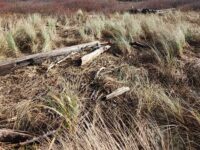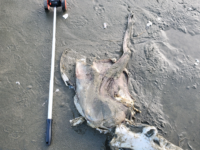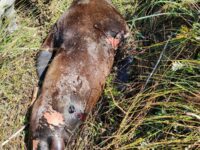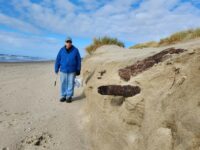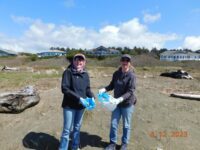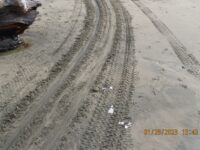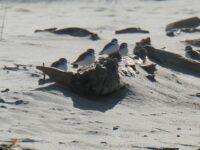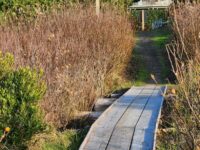Mile 203 Report
Driftwood Beach south, Hidden Lake
March 21, 2022
It was a cloudy, drizzly, overcast day with a very strong South Wind that was blowing the sand.
Report Details
It was a cloudy, drizzly, overcast day with a very strong South Wind that was blowing the sand. Humans had erected numerous wood poles in beach by foredunes by Sandpiper Village. These should be removed. They provide perches for birds of prey and Ravens and Crows to feed on shorebirds. Wrack consisted mostly of small vegetation and small stones. A very large piece of driftwood had washed in with an enormous piece of rope from a ship. The beach was mostly flat and would provide little plover nesting habitat, if any. The foredunes were riddled with dog and human tracks and activity for the whole mile. Several small streams were makiing their way to the ocean. The tides had come all the way to the foredunes for most of the way. Dogs were not leashed, but stayed with the owners. Picked up one bag of trash. Mostly small items.
Conditions
Temperature: 46 F. Cloud Cover: Rain. Wind Velocity: Strong. Wind Direction: S. Tide Level: 1.2 feet.
Human Activities
Number of people: 4. Number of dogs: 3. Walking or running: 4. Other Activities: Evidence of sand castle building and walking and playing in foredunes. Foredunes had been trampled with human and dog tracks.. Tracks from Park Ranger's ATV. Foredune activity was seen all along the mile. Suspect people were in dunes to escape the blowing sand and strong wind
Concerns
Climbing bluffs/seastacks
Apparent violations: climbing and playing in bluffs/foredunes.Disturbances: Shorebirds moving in response to humans/dogs
Vehicles
Notable Wildlife
A large flock of gulls at Buckley Creek . 100+
Driftline Content
Small rocks, Seaweeds and seagrass, Shells, Animal casings (e.g., crab, shrimp molt), Wood pieces, Land-based debris (picnics, etc.), Marine debris (plastic, styrofoam, etc. washing in from the sea), Styrofoam, Ocean-based debris (from fishing boats, ship trash, etc.). A lot of rope, especially a large one that most likely belonged to a boat. I could not pick it up due to size and weight
Man-made Modifications
Dune modification/removal. Degradation to dunes due to human and dog traffic and playing by children (slides, etc.)
Natural Changes
Newly exposed roots/trees falling, Erosion of vegetated foredune, Visible retreat of solid bluff, Evidence of wave overtopping. Increase in log jam at Buckley Creek.
Actions & Comments
No actions taken













Report Images
All Mile 203 Reports
Mile 203
Driftwood Beach south, Hidden Lake
The beach has had substantial washing away of old dunes and washing up of beach grass into the dunes. There were 45 bird carcasses of we believe are Cassin's auklets.
Jeff Hildreth
Mile 203
Driftwood Beach south, Hidden Lake
Today I and my two CoastWatch partners conducted a NOAA Marine Debris survey on our 100 meter survey site at Sandpiper Beach, Mile 203. On reaching our marine debris survey site, we saw a lot of Cassin's Auklet carcasses, which COASST calls CAAU, all high up on the beach among the beach vegetation and washed-in sea grass, many carcasses partially covered by sand or vegetation. After we completed our debris survey, I returned to our survey site and began collecting CAAU carcasses in groups of 9, as COASST recommends, ultimately collecting 40 carcasses in 4 full and 1 partial grouping. Below is a link to our Sandpiper Beach NOAA debris survey site where most CAAUs were found, reached by a boardwalk that enters the beach midway in the debris survey site. COASST defines a "wreck" as more than 20 beached individuals of one species per kilometer, and a "MME" (Massive Mortality Event) as a spike of up to hundreds of carcasses per kilometer. We also found a beached Northern Fulmar and what is I believe was either a female Gadwall or White-winged Scoter, which I took note of but didn't measure or report on to COASST. I submitted documentation with photos of the CAAU beaching event to COASST, and COASST responded that they had received reports of CAAU beachings from Southern Oregon sites like Coquille Point and Cape Blanco but also as far north as Manzanita. All this sounds very dry, but it was really sad to see and handle all these beautiful little dead birds and wonder if this is completely natural or if climate change, and perhaps a decline of prey species making these birds more vulnerable, factors into these mortality events. https://mdmap.
Jon French
Mile 203
Driftwood Beach south, Hidden Lake
The storms and rain caused some beach washout from the ocean and from the land.
JLcoasties
Mile 203
Driftwood Beach south, Hidden Lake
The dunes have reappeared due to the spring winds.
JLcoasties
Mile 203
Driftwood Beach south, Hidden Lake
Last year at this time, Jesse Jones helped us set up a 100 meter NOAA marine debris survey site on Mile 204, which we later moved to Sandpiper Beach on Mile 203.
Jon French
Mile 203
Driftwood Beach south, Hidden Lake
It was a beautiful day for a walk.
Nancy Thomas
Mile 203
Driftwood Beach south, Hidden Lake
After observing 8 snowy plovers on Mile 200 yesterday, I wanted to check up on the plovers on Mile 203.
KFunk
Mile 203
Driftwood Beach south, Hidden Lake
New beach access point, 66B, has been installed on mile 203.
JLcoasties

